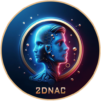
At 2DNAC, the creation of digital doubles represents the pinnacle of our dedication to combining artistry with the most advanced technological tools in the field. These digital characters are meticulously crafted to serve not only in entertainment but also in a variety of interactive applications, offering an immersive experience that is virtually indistinguishable from reality. This post delves into the specialized software and hardware that 2DNAC employs to sculpt, animate, and render our high-fidelity digital doubles.
3D Modeling
The creation of a digital double starts with 3D modeling, where the visual representation of the character is crafted. At 2DNAC, we utilize advanced software like Autodesk Maya, Blender and Zbrush to build detailed 3D models. These models are meticulously sculpted, textured, and rigged in preparation for animation. The precision of our 3D modeling process is crucial, as it lays the groundwork for the high level of realism for which our digital doubles are known.
Advanced Rendering Techniques
After modeling and animation, rendering breathes life into our digital doubles. 2DNAC employs cutting-edge rendering techniques, including ray tracing and global illumination, to produce photorealistic visuals. These techniques simulate realistic lighting and shadows, providing our characters with a depth and authenticity that can fool the eye. The meticulous attention to detail in our rendering process ensures that each digital double we create can withstand the scrutiny of the closest inspection, whether in film, video games, or interactive media.
Real-Time Interaction Tools
While AI is commonly used in the industry, 2DNAC focuses on real-time rendering technologies to empower our digital doubles. Using powerful platforms like Unreal Engine, our characters are able to interact dynamically with their environments and users. This capability is essential for applications requiring immediate feedback, such as virtual reality (VR) and augmented reality (AR), ensuring our digital doubles can engage users effectively and seamlessly in real time.
Conclusion
The technology behind 2DNAC’s digital doubles involves a sophisticated array of tools and processes that transform digital art into living entities. By harnessing advanced MoCap, precise 3D modeling, and photorealistic rendering, along with real-time interaction technologies, 2DNAC continues to lead in the creation of digital doubles that are not only visually stunning but also capable of engaging with their environment in meaningful ways. As we move forward, 2DNAC remains committed to pushing the boundaries of what is possible in the digital realm, continually improving our processes to meet and exceed the evolving demands of our clients and their audiences.
